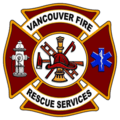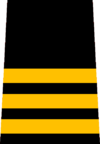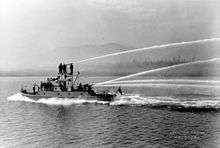Vancouver Fire and Rescue Services
 | |
| People Who Care About You | |
| Agency overview | |
|---|---|
| Established | 1886 |
| Employees | 800 |
| Staffing | Career |
| EMS level | First Responder |
| Facilities and equipment | |
| Stations | 20 |
| Engines | 12 |
| Trucks | 6 |
| Ladders | 6 |
| Quints | 12 |
| Rescues | 3 |
| Fireboats | 2 |
| Website | |
| VFRS | |
Vancouver Fire and Rescue Services (V.F.R.S.) was founded in 1886 and today serves the city of Vancouver, British Columbia providing fire, medical first response, rescue and extrication services. In 2014, the V.F.R.S. responded to 50,000 emergency calls.[1]
History
The Vancouver Volunteer Fire Brigade was established in 1886 with one volunteer hose-wagon company assigned to protect the new city which mainly had lumber mills at the time, and within 16 days of its existence, the city of Vancouver burned to the ground.[2] A week after the fire the city purchased its first fire engine from Ontario, the item arrived in August of that year, which made the volunteers confident that they could handle any situation that occurred. A second engine arrived in 1888 along with two new firehalls growing the strength from one company to three companies. J.H. Charlisle was appointed the city's first fire chief who began motorizing fire brigade...the first motorized fire engine was purchased in 1908 from the Seagrave company of Columbus. By 1911, the department was ranked third best in the world, falling behind London and Leipzing Germany. By 1917 it was completely motorized (no more horse-drawn equipment) and was then recognized as the Vancouver Fire Department.[2][3] In 1929 the municipalities of South Vancouver and Point Grey amalgamated with the City of Vancouver which also meant the merger of the South Vancouver Fire Department and the Point Grey Fire Brigade, which added six new halls and increased the strength of the department by 100 men.
Since 1893, 48 Vancouver firefighters have died in the line of duty.[4]
Operations
Rank Structure
| Fire Chief | Deputy Fire Chief | Assistant Chief | Battalion Chief | Training Officer | Captain | Lieutenant | Firefighter | Probationary Firefighter | |
|---|---|---|---|---|---|---|---|---|---|
| Rank Epaulettes |  |
 |
 |
 |
 |
 |
 |
No Insignia | No Insignia |
| Rank Pins | .png) |
.png) |
.png) |
.png) |
.png) |
.png) |
.png) |
No Insignia | No Insignia |
Current Fire Chief and General Manager - John McKearney
Fire Hall Locations and Apparatus
There are currently 20 Fire Halls located throughout the city of Vancouver, organized into three Battalions.
| Fire Halls & Neighbourhoods | Engines | Ladders & Towers | Quints | Medics & Rescues | Battalion Chiefs & Specials | Addresses | Opening Dates |
|---|---|---|---|---|---|---|---|
| 1 (Strathcona) | Engine 1 | Ladder 1 | Medic 1 | Battalion Chief 1, Car 73 (Fire Investigator), Pod 1, Logistics, Mechanic 1, Mechanic 2, Special Operations | 900 Heatley Avenue | 8/8/75 | |
| 2 (Downtown Eastside) | Engine 2 | Quint 2 | Medic 2 | 199 Main Street | 8/8/75 | ||
| 3 (Mount Pleasant) | Engine 3 | Ladder 3 | Rescue 3 | 2801 Quebec Street | 1/27/01 | ||
| 4 (Fairview) | Quint 4 | Medic 4 | Command 4 | 1475 West 10th Avenue | 5/11/92 | ||
| 5 (Killarney) | Engine 5 | 3090 Rosemont Drive | 5/13/15 | ||||
| 6 (West End) | Engine 6 | Quint 6 | 1001 Nicola Street | 3/18/89 | |||
| 7 (Downtown) | Engine 7 | Ladder 7, Ladder 27 | Rescue 7 | 1090 Haro Street | 12/5/74 | ||
| 8 (Yaletown) | Engine 8 | Medic 8 | Wildlands 8 | 895 Hamilton Street | 12/5/74 | ||
| 9 (Grandview-Woodland) | Quint 9 | Medic 9 | Technical Rescue 9 | 1805 Victoria Drive | 2/12/60 | ||
| 10 (UBC) | Engine 26 | Tower 10 | Quint 10 | Wildlands 10 | 2992 Wesbrook Mall | 1982 | |
| 12 (Kitsilano) | Quint 12 | Medic 12 | Hose Tender | 2460 Balaclava Street | 7/11/87 | ||
| 13 (Riley Park) | Quint 13 | Air & Light 13, Rehab Support Unit 13, Clothing Wagon | 4013 Prince Albert Street | 4/4/03 | |||
| 14 (Hastings-Sunrise) | Engine 14, Engine 29 | Medic 14 | 2804 Venables Street | 8/13/79 | |||
| 15 (Renfrew-Collingwood) | Engine 15 | Quint 15 | Medic 15 | Battalion Chief 2, Spare Pumper | 3003 East 22nd Avenue | 3/26/12 | |
| 17 (Victoria-Fraserview) | Engine 17 | Ladder 17 | Rescue 17 | 7070 Knight Street | 6/3/55 | ||
| 18 (Shaughnessy) | Engine 18 | Quint 18 | Battalion Chief 3, Hazmat 18, Hazmat Tender 18, Mask Repair | 1375 West 38th Avenue | 7/22/00 | ||
| 19 (West Point Grey) | Quint 19 | 4396 West 12th Avenue | 7/3/80 | ||||
| 20 (Kensington-Cedar Cottage) | Quint 20 | Antique Engine | 5402 Victoria Drive | 11/9/62 | |||
| 21 (Kerrisdale) | Quint 21 | 5425 Carnarvon Street | 6/7/85 | ||||
| 22 (Marpole-Oakridge) | Engine 22 | Ladder 22 | Wildlands 22, Hazmat Tender 22 | 1005 West 59th Avenue | 6/18/82 |
Fire Boats

VFRS has 4 aluminum fire boats, Fireboats 1, 3, 4 and 5. They were designed by naval engineering firm Robert Allan Ltd. One new boat built by MetalCraft Marine of Ontario arrived in 2016, a second is expected to arrive in 2017. Three of the Robert Allen designed boats will be retired, while the fourth will be kept as a reserve. The boats also serve neighbouring municipalities.
Former fireboats:
- J.H. Carlisle 1928-1971
- Fireboat No. 2 1951-1987
Crest
VFRS uses a standard logo displayed on uniforms and vehicles:
- Maltese cross
- fire hydrant
- EMS Star of Life
- helmet,ladder, horn, hook and axe
Response
Tap Out Response Medical Aids
| Call Type | Number Of Rigs Needed |
|---|---|
| General | 1 |
| Cardiac Arrest | 2 If Needed |
| Stroke | 2 If Needed |
| Multiple Patients
(Stabbing, Shooting) |
2 Rigs And Battalion |
Tap Out Response Non Medicals
| Call Type | Number Of Rigs |
|---|---|
| Motor Vehicle Incident | 1 Pumping Rigs |
| Motor Vehicle Incident
Multiple Patients |
1 Pumping Rig
1 Medic Or Rescue |
| Motor Vehicle Rollover | 3 Pumping Rigs
1 Rescue and Battalion |
| Fire Alarm | 2 Pumping Rigs |
| Rubbish Fire | 1 Engine or Quint |
| Vehicle Fire | 1 Engine or Quint |
| Vehicle Fire
Alternating Fuels |
2 Pumping Trucks |
| Wildland Fire
Small Area |
1 Engine Or Quint |
| Wildland Fire Large Area | 2 Pumping Trucks |
Structure Fire Response
| Alarm | Pumping Rigs | Ladders | Rescue/Medics | Battalions/Support |
|---|---|---|---|---|
| 1st Alarm | 3 | 1 | 1 | 1 |
| Working Fire | 1 | 1 Rescue
(Man Air Light RIT) |
1 Battalion Air 13
RS 13 Car 73 | |
| 2nd Alarm | 2 | 1 | (1 Rescue If Needed) | |
| 3rd Alarm | 2 | |||
| 4th Alarm | 2 | Deputy Chief If Needed
Command Vehicle If Needed | ||
| 5th Alarm (After
Approval Only) |
2 | 1 | Command Vehicle If Needed |
Busiest Fire Halls
| Fire Hall | Location | Number Of Calls | Busiest Apparatus |
|---|---|---|---|
| Fire Hall 2 | Downtown Eastside | 1200+ per month | Medic 2 |
| Fire Hall 7 | Downtown | 100+ per month | Engine 7 |
| Fire Hall 8 | Yaletown | 50+ per month | Wildlands/Medic 8 |
Call Volumes
| Year | Overall | Busiest Unit | Top Call |
|---|---|---|---|
| 2013 | 30,000 | Engine 7 | Medical Aid |
| 2014 | 38,000 | Engine 2 | Medical Aid |
| 2015 | 44,000 | Medic 2 | Medical Aid |
Major incidents and disasters
On June 13, 1886, workers were burning brush to make way for development when high winds picked up the flames and began burning out of control. Vancouver Volunteer Hosewagon Company No. 1, comprising a dozen volunteers, grabbed buckets and axes in attempt to extinguish the conflagration. The city had purchased a fire engine which had not yet arrived resulting in most of the city being burned down in 45 minutes.
BC Forest Products:
On July 3, 1960, a fire broke out at the BC Forest Products Mill near Oak St and W 6th Ave resulting in the VFRS's first five-alarm fire. 350 firefighters battled the flames for hours on the hot day. Most of the mill was burnt down before the fire was extinguished.
Stanley Cup Riot (2011):
On June 15, 2011, the Vancouver Canucks lost game 7 of the Stanley Cup finals to the Boston Bruins which resulted in a violent riot. VFRS Fire Halls 1, 2, 6, 7 and 8 were kept busy that night dealing with a large number of burning vehicles, arson, medical aids, complaints, and vandalisms to retail stores and buildings. One firefighter was injured when he was assaulted by a rioter who demanded treatment for pepper spray deployed by police. In 2012, it was decided that VFRS's members were to be added to VPD's Public Safety Unit (crowd control unit, as mentioned above.)
Granville Seniors Center
Calls started coming in around 6:50 pm on October 3, 2014 about a fire at a construction site on Granville Street and W 49th Avenue in Vancouver. Initial units that were dispatched were able to see the large column of thick black smoke that was visible all around the Lower Mainland. Vancouver Battalion Chief 3 made it a working fire before any crews arrived on scene. Once crews arrived on scene they reported a large working structure fire of a 4 or 5 story complex under construction. Fire had originated in the top floor and was spreading quickly. Before crews arrived it had engulfed most of the roof and was spreading to the sides quickly. On arrival of Battalion Chief 3, he immediately made it a 3rd Alarm Fire as large amounts of crews were required to knock the fire down and prevent exposure of nearby buildings. Granville Street was quickly shutdown, creating major traffic problems and the Vancouver Police Department were called in for traffic control. British Columbia Ambulance Service was also request for standby. The fire was quickly upgraded to a 4th Alarm before crews were able to get the fire under control. Security on site had reported that there may be some propane tanks inside the building for construction use. The roof and sides of the building began to collapse after about an hour and police pushed most spectators back a block or more. Rehab and Command was set up at Granville Street & W. 49 Ave. Staging was also set up on Granville Street & W. 49 Ave on W. 49 Ave on the North side. 1 Firefighter required medical treatment after the majority of the fire was knocked down and no other injuries were reported. The trolley cables for the electric buses were shut down on Granville Street due to the proximity of the fire. Crews remained on scene during the night and all day on Saturday October 4. In the late morning of the 4th Granville Street had to be closed to traffic for more than an hour after a large flare up required several units to be brought in to help fight the flare up.
Port Metro Vancouver Fire:
On March 4, 2015, a security guard at the Port of Vancouver noticed smoke coming from a shipping container. He immediately notified E-Comm 911 which in turn activated a report of a smoke call. Battalion 1 was placed in charge of the scene and upon arrival, declared the incident a structural fire for thick white smoke could be seen emerging from the container. A working alarm assignment was declared immediately followed by a 2nd alarm which included response from Hazmat 18, Vancouver Police, and BC Ambulance Service. Hazmat 18 crew identified the burning content as trichloroisocyanuric acid, a dangerous chemical. Command immediately declared the event as a 3rd alarm and additional police units were called in to evacuate the zone. Warnings were issued to people living in the vicinity to stay at home and lock their doors and windows to prevent gas from entering. At around 3 pm, a 4th alarm was declared and Command 4 was dispatched to the scene along with assistant chiefs. Command 4 requested fireboats 3 and 5 attend the scene. Fire boats worked from the water side to extinguish the fire while firefighters attacked the flames from aerial ladders. Crews remained on scene for several days trying to put out hot spots.
Training Facility
The Vancouver Fire Rescue Services training facility (also known as the Chess Street training grounds) has a burn building and several classrooms. There is also a base for the CAN-1 HUSAR (Canadian Heavy Urban Search And Rescue Team), the only HUSAR team in Canada that can be deployed anywhere in the world. The training facility also hosts the department's youth academy outreach program, a week long firefighting academy for senior high school students. BC first responders level 3 and the first aid course required by firefighters is also taught at this facility.
See also
- E-Comm, 9-1-1 call and dispatch centre for Southwestern BC
- BC Ambulance Service
References
- ↑ Vancouver Fire and Rescue Services | City of Vancouver. Vancouver.ca. Retrieved on 2014-04-12.
- 1 2 "History of Vancouver - Vancouver Fire and Rescue: Early Days". Vancouverhistory.ca. 2004. Retrieved 2010-11-25.
- ↑ http://www.vffhs.com/history/
- ↑ "In The Line Of Duty". IAFF 18. 2010. Retrieved 2010-11-25.